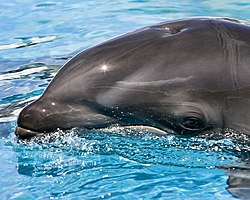| Wholphin | |
|---|---|
 | |
| Kawili Kai, born to Kekaimalu (a female wholphin) by a male dolphin, at 9 months of age in September 2005 | |
| Scientific classification | |
| Kingdom: | Animalia |
| Phylum: | Chordata |
| Class: | Mammalia |
| Order: | Artiodactyla |
| Infraorder: | Cetacea |
| Superfamily: | Delphinoidea |
| Family: | Delphinidae |
| Hybrid: | Tursiops truncatus × Pseudorca crassidens |
A wholphin(portmanteau of whale and dolphin) is an extremely rare cetacean hybrid born from a mating of a female common bottlenose dolphin (Tursiops truncatus) with a male false killer whale (Pseudorca crassidens). [1] The name implies a hybrid of whale and dolphin, though taxonomically, both are in the oceanic dolphin family, which is in the toothed whale clade. This type of hybrid was considered unexpected given the sometimes extreme size difference between a female common bottlenose dolphin (typically 2 meters long and 300 kilograms) and a male false killer whale (over 5 meters long and over 1,800 kg). Wholphins have been born in captivity and have also been reported in the wild. [2] [3]
Contents
- Examples
- Family tree
- Capabilities and behaviour
- Exterior and physical description
- References
- External links
Wholphins also exhibit physical and behavioural characteristics intermediate between those of their parent species. While much larger than most dolphins, the wholphin becomes an exceptional example of hybrid vigour.[ clarification needed ]
